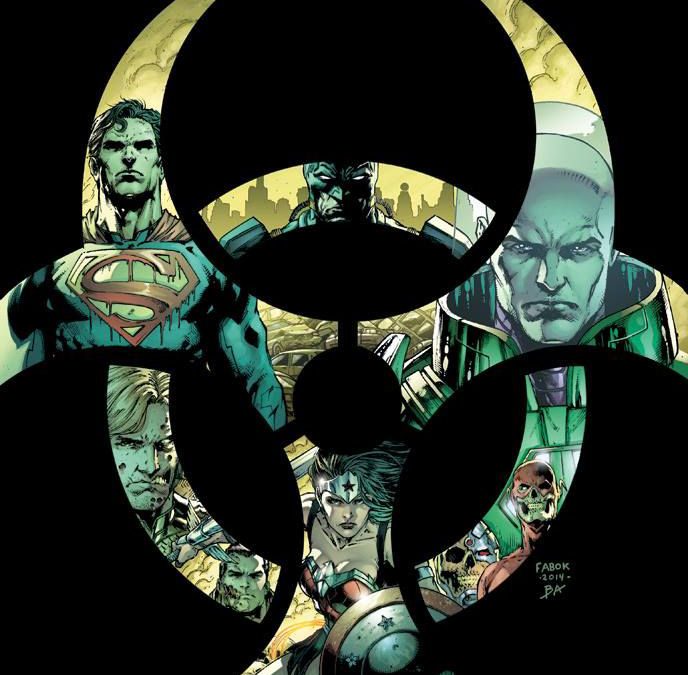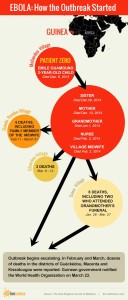People are sick in DC Comics’ Justice League. Really sick. And they need to find the Amazo Virus’ Patient Zero.
Whu?
The (super) short, mildly spoiler-y version: Lex Luthor created a virus using an artificial enzyme from the android, Amazo. Luthor’s idea was that the virus would suppress the metahuman abilities of individuals who demonstrated them, particularly, those with violent tendencies, but this is Luthor we’re talking about, so yeah, there was probably more to his idea.
The virus was deemed too controversial, and Luthor locked it up in his personal lab – which was attacked by Neutron (the super-villain, not the sub-atomic particle) in Justice League #35. The virus was released, and as of Justice League #36, somewhere north of 520 people (including the human members of the Justice League and Neutron) were infected, and are all in some stage of the disease, which seems to be 100% lethal. As Luthor explains it, when the virus hits humans (and finds no meta human powers) it “gives” the infected human powers (random picks). Apparently, it was supposed to leave regular humans alone, but this switch-up is a mutation that somehow happened, Luthor figures, in Patient Zero.
Here’s the thing, then – Superman and Batman spent all of issue #36 on the hunt for, and i ssue #37, fighting Dr. Armen Ikarus – “Patient Zero.”
ssue #37, fighting Dr. Armen Ikarus – “Patient Zero.”
But what is a Patient Zero?
It’s a term that is pushing into the mainstream conversation more and more. Patient Zero of the recent Ebola outbreak was identified in October of last year. The story of locating Patient Zero of the AIDS epidemic is one of the best detective stories you’ve never heard (check out this Radiolab episode for more). Movies, books, and now comics are peppered with references to “Patient Zeroes.”
Which brings up the question – what is a “Patient Zero,” and why is it so important to find them?
Patient Zero is the start of an infection, and as such, can sometimes called the first or, “index case” of an epidemiological investigation. Patient Zero is the person who first got the disease from a non-human source, and starts to spread it to other humans.
In the case of the most recent Ebola outbreak, Patient Zero was discovered to be a two-year-old boy named Emile Oumouno who died December 6, 2013 in Guinea. From young Emile, the disease spread to his sister, mother, grandmother, and then two healthcare works in the village in which he lived: a nurse and a midwife. From there, the disease rapidly spread.
Patient Zero is the first human to be infected, so the infection comes from some other source. In Emile’s case that source is suspected to be free-tailed bats. While bats are often captured and eaten (they’re included in the larger group of “bushmeat” frequently eaten by indigenous people), it’s more likely that Emile was bitten or scratched by a bat carrying the current strain of Ebola, as children reportedly caught and played with the bats.
In the case of Emile as Patient Zero, the current Ebola outbreak can be traced back to a single individual – a single zoonotic jump (from animals to humans), which means that there doesn’t seem to be an “open faucet” that’s exposing new people over and over again. Which is kind of good – the disease can be controlled then by just taking care of the sick and preventing further human-to-human spread – which has been the strategy since the outbreak came to light.
So – finding Patient Zero can tell you, or at least point you to the door the infection used to get into the human population and how it initially spread. But what can you do with a Patient Zero once you find them?
First things first – in the real world, finding the Patient Zero isn’t usually that important to finding a cure, creating a vaccine or stopping the spread of the disease. For example, it’s been over thirty years since the worldwide HIV/AIDS epidemic spread from its Patient Zero, and many questions still remain. And knowing who the HIV Patient Zero was didn’t bring us any close to the cure. It only explained how the virus was able to spread throughout the world so rapidly, affecting specific demographics.
Unfortunately, as in the case of HIV’s Patient Zero and in Emile’s case, Patient Zero is the first, or one of the first casualties of the disease. But sometimes, Patient Zero survives the infection and is only acting to spread the disease – that was the case with Mary Mallon, a.k.a., Typhoid Mary (her story is detailed in the Radiolab episode, too). That means that Patient Zero is a carrier – alive while infected and spreading the disease. That’s pretty rare and at the same time, pretty significant. That means that somehow, the individual’s immune system is able to produce antibodies that fight the virus that has infected it.
Antibodies are the body’s response to an antigen, or foreign substance that has invaded the body – in Mary’s case, proteins from the type of Salmonella bacteria that causes typhoid fever. In a normal antigen response, a macrophage (a type of white blood cell) encounters a new antigen, engulfs and digests it, and “shows” some of the antigen’s “guts” on its surface – kind of like a trophy of its kills. Similar trophies are displayed on the surface of another type of white blood cells, B lymphocytes, as well.
When a B cell spots an antigen that is in its collection of “kills,” or gets a message from another lymphocyte, a T cell, that a macrophage has ingested the antigen that it knows how to kill, the B cell springs into action. While it undergoes a number of changes, the most important is that it starts to produce antibodies to the specific antigen. These antibodies are designed by the immune system to either kill bacteria directly, or coat the antigen, and make it easier for the macrophages to engulf and digest.
 The idea that’s been shown repeatedly in movies, television, novels and comics is that the Patient Zero, if they are still alive, carries the antibodies that can be used to make a cure for the disease or create a vaccination to prevent the spread of the disease. That can happen – such as in the case of Amber Vinson, a Dallas Ebola victim who donated her blood to Xbiotech, a company that clones antibodies directly from disease-resistant humans.
The idea that’s been shown repeatedly in movies, television, novels and comics is that the Patient Zero, if they are still alive, carries the antibodies that can be used to make a cure for the disease or create a vaccination to prevent the spread of the disease. That can happen – such as in the case of Amber Vinson, a Dallas Ebola victim who donated her blood to Xbiotech, a company that clones antibodies directly from disease-resistant humans.
But again – finding Patient Zero is often a long, difficult process, having them still be alive by the time they are found is rare, and being able to create a cure because the Patient Zero produced antibodies is, again, difficult and likewise very rare.
By the way – to return to perhaps the most famous Patient Zero, Typhoid Mary – after she died in 1938, doctors did find Typhoid in her. But Mary’s case is still being studied. Recently, researchers at Stanford showed that in some cases, possibly such as Mary’s, the Salmonella bacteria that causes Typhoid fever can survive inside macrophages, waiting out the body’s immune response, and then continuing to live and reproduce within the host. That’s creepy, but offers a suggestion about how Mary was able to infect more than 50 people while remaining symptom herself.
The Amazo Virus storyline began in Justice League #35, and is currently still running in the series. Luthor’s shenanigans have, of course, been revealed. That guy loves his shenanigans.
More:
Ebola ‘Patient Zero’: How Outbreak Spread from a Single Child
Patient Zero Believed to be Sole Source of Ebola Outbreak









